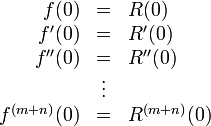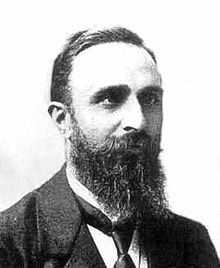Padé approximant
In mathematics a Padé approximant is the "best" approximation of a function by a rational function of given order – under this technique, the approximant's power series agrees with the power series of the function it is approximating. The technique was developed around 1890 by Henri Padé, but goes back to Georg Frobenius who introduced the idea and investigated the features of rational approximations of power series.
The Padé approximant often gives better approximation of the function than truncating its Taylor series, and it may still work where the Taylor series does not converge. For these reasons Padé approximants are used extensively in computer calculations. They have also been used as auxiliary functions in Diophantine approximation and transcendental number theory, though for sharp results ad hoc methods in some sense inspired by the Padé theory typically replace them.
Definition
Given a function f and two integers m ≥ 0 and n ≥ 1, the Padé approximant of order [m/n] is the rational function
which agrees with f(x) to the highest possible order, which amounts to
 .
.
Equivalently, if R(x) is expanded in a Maclaurin series (Taylor series at 0), its first m + n terms would cancel the first m + n terms of f(x), and as such:
The Padé approximant is unique for given m and n, that is, the coefficients  can be uniquely determined. It is for reasons of uniqueness that the zero-th order term at the denominator of R(x) was chosen to be 1, otherwise the numerator and denominator of R(x) would have been unique only up to multiplication by a constant.
can be uniquely determined. It is for reasons of uniqueness that the zero-th order term at the denominator of R(x) was chosen to be 1, otherwise the numerator and denominator of R(x) would have been unique only up to multiplication by a constant.
The Padé approximant defined above is also denoted as
Computation
For given x, Padé approximants can be computed by Wynn's epsilon algorithm[1] and also other sequence transformations[2] from the partial sums
of the Taylor series of f, i.e., we have
f can also be a formal power series, and, hence, Padé approximants can also be applied to the summation of divergent series.
One way to compute a Padé approximant is via the extended euclidean algorithm for the polynomial gcd.[3] The relation
is equivalent to the existence of some factor K(x) such that
 ,
,
which can be interpreted as the Bézout identity of one step in the computation of the extended gcd of the polynomials  and
and  .
.
To recapitulate: to compute the gcd of two polynomials p and q, one computes via long division the remainder sequence
 ,
,
k =1, 2, 3, ... with  , until
, until  . For the Bézout identities of the extended gcd one computes simultaneously the two polynomial sequences
. For the Bézout identities of the extended gcd one computes simultaneously the two polynomial sequences
to obtain in each step the Bézout identity
 .
.
For the [m/n] approximant, one thus carries out the extended euclidean algorithm for
and stops it at the last instant that  has degree n or smaller.
has degree n or smaller.
Then the polynomials  give the [m/n] Padé approximant. If one were to computes all steps of the extended gcd computation, one would obtain an anti-diagonal of the Pade table.
give the [m/n] Padé approximant. If one were to computes all steps of the extended gcd computation, one would obtain an anti-diagonal of the Pade table.
Riemann–Padé zeta function
To study the resummation of a divergent series, say
it can be useful to introduce the Padé or simply rational zeta function as
where
is the Padé approximation of order (m, n) of the function f(x). The zeta regularization value at s = 0 is taken to be the sum of the divergent series.
The functional equation for this Padé zeta function is
where aj and bj are the coefficients in the Padé approximation. The subscript '0' means that the Padé is of order [0/0] and hence, we have the Riemann zeta function.
DLog Padé method
Padé approximants can be used to extract critical points and exponents of functions. In thermodynamics, if a function f(x) behaves in a non-analytic way near a point x = r like  , one calls x = r a critical point and p the associated critical exponent of f. If sufficient terms of the series expansion of f are known, one can approximately extract the critical points and the critical exponents from respectively the poles and residues of the Padé approximants
, one calls x = r a critical point and p the associated critical exponent of f. If sufficient terms of the series expansion of f are known, one can approximately extract the critical points and the critical exponents from respectively the poles and residues of the Padé approximants ![\left[n/n+1\right]_{{g}}\left(x\right)](/2014-wikipedia_en_all_02_2014/I/media/7/5/6/c/756c98f3886a0847e94541a94e9110c3.png) where
where  .
.
Generalizations
A Padé approximant approximates a function in one variable. An approximant in two variables is called a Chisholm approximant, in multiple variables a Canterbury approximant (after Graves-Morris at the University of Kent).
See also
References
- ↑ Theorem 1 in Wynn, Peter (Mar 1966), "On the Convergence and Stability of the Epsilon Algorithm", SIAM Journal on Numerical Analysis 3 (1): 91–122, Bibcode:1966SJNA....3...91W, doi:10.1137/0703007, JSTOR 2949688
- ↑ Brezenski, C. (1996), "Extrapolation algorithms and Padé approximations", Applied Numerical Mathematics 20 (3): 299–318, doi:10.1016/0168-9274(95)00110-7
- ↑ Problem 5.2b and Algorithm 5.2 (p. 46) in Bini, Dario; Pan, Victor (1994), Polynomial and Matrix computations - Volume 1. Fundamental Algorithms, Progress in Theoretical Computer Science, Birkhäuser, ISBN 0-8176-3786-9
Literature
- Baker, G. A., Jr.; and Graves-Morris, P. Padé Approximants. Cambridge U.P., 1996
- Baker, G. A., Jr. Padé approximant, Scholarpedia, 7(6):9756.
- Brezinski, C.; and Redivo Zaglia, M. Extrapolation Methods. Theory and Practice. North-Holland, 1991
- Press, WH; Teukolsky, SA; Vetterling, WT; Flannery, BP (2007), "Section 5.12 Padé Approximants", Numerical Recipes: The Art of Scientific Computing (3rd ed.), New York: Cambridge University Press, ISBN 978-0-521-88068-8
- Frobenius, G.; Ueber Relationen zwischem den Näherungsbrüchen von Potenzreihen, [Journal für die reine und angewandte Mathematik (Crelle's Journal)]. Volume 1881, Issue 90, Pages 1–17
- Gragg, W.B.; The Pade Table and Its Relation to Certain Algorithms of Numerical Analysis [SIAM Review], Vol. 14, No. 1, 1972, pp. 1–62.
- Padé, H.; Sur la répresentation approchée d'une fonction par des fractions rationelles, Thesis, [Ann. \'Ecole Nor. (3), 9, 1892, pp. 1–93 supplement.
- Wynn, P. (1966), "Upon systems of recursions which obtain among the quotients of the Padé table", Numerische Mathematik 8 (3): 264–269, doi:10.1007/BF02162562
External links
- Weisstein, Eric W., "Padé Approximant", MathWorld.
- Module for Padé Approximation, John H. Mathews California State University, Fullerton
- Padé Approximants, Oleksandr Pavlyk, The Wolfram Demonstrations Project
- A Short Introduction to Padé Approximants, Jerome Soucy Université Laval
- Data Analysis BriefBook: Pade Approximation, Rudolf K. Bock European Laboratory for Particle Physics, CERN
- Sinewave, Scott Dattalo, last accessed 2010-11-11.
- Padé module, Bengt Fornberg, University of Colorade at Boulder, Course-material 2011; last accessed 16.Feb 2012.
- MATLAB function for Pade approximation of models with time delays.



![[m/n]_{f}(x).\,](/2014-wikipedia_en_all_02_2014/I/media/7/a/0/d/7a0dc8a9d1149451ca54a7e3001eb4a2.png)







![R(x)=[m/n]_{{f}}(x)\,](/2014-wikipedia_en_all_02_2014/I/media/b/8/d/1/b8d1aa03945bcddfd69e71065423df34.png)
